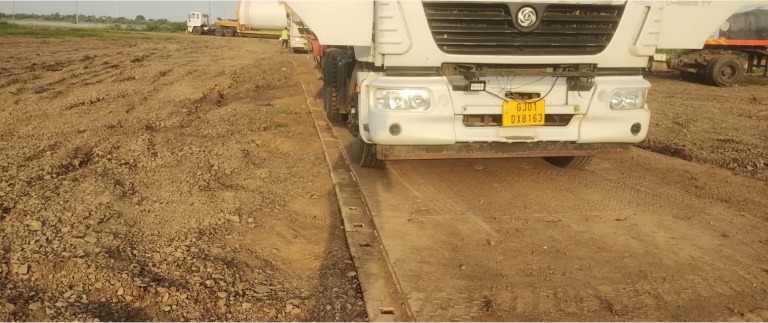A Remote Site in India
It begins on a damp morning in rural Maharashtra. A pipeline crew is preparing to lay a new branch line over black cotton soil—soggy, sticky, and unpredictable. The project manager notes:
“We need a stable route for trucks and cranes, and minimal ground disturbance.” That’s when
temporary road mats become indispensable.
Step 1: Assess the Site
Understand the terrain
- Soil type: muddy, clay-heavy soils (like black cotton soil, common in parts of India) swell when wet and may not bear weight well.
- Weather conditions: Monsoon seasons can turn fields into mud pits.
- Environmental sensitivity: forests, wetlands, protected heritage areas demand mats that don’t crush vegetation or contaminate soil.
This assessment guides your mat selection.
A team arrives at a wind-farm site in Gujarat. On one side, soft saline flatland. On the other, rough undulating ground. They mentally split the site into zones—each requiring different mat solutions.
Step 2: Choose the Right Mat Type
- a) HDPE Composite Mats (e.g. Porta Deck, Dura‑Base, ISOtrack)
- Material: high-density polyethylene (HDPE), often foam‑filled, chemical‑resistant, UV‑stable.
- Load capacity: up to ~425 t/m² (≈605 psi), supporting heavy vehicles and cranes.
- Design: interlocking surface tread or traction pattern for slip resistance; flexible to conform to undulating ground.
- Benefits: reusable, light compared to steel/wood mats, minimal ground prep, no water absorption.
Ideal for: muddy, waterlogged, clay-heavy soils, environmental-sensitive areas, remote job sites.
Step 3: Mat to Application
| Application |
Recommended Mat |
| Soft clay, marshy ground, sensitive ecosystems |
HDPE composite mats (e.g. Porta Deck, Dura‑Base) |
| Forest trails, remote logging, crane staging |
Steel‑framed hardwood rig mats or swamp mats |
| Temporary crane pads or helipads |
Heavy‑equipment crane mats |
For example,
Porta Deck mats from Mtandt Rentals handle up to 425 tons/sqm over slushy, undulated terrain, with dual traction, interlocking, foam‑filled cores—perfect for Indian monsoon‑affected soils.
Step 4: Planning Deployment (Before Arrival)
- Calculate area and mat count: measure length and width of access roads or staging pads; account for overlaps or turning zones.
- Logistics: HDPE mats are lighter (≈360 kg per 4 m × 2 m unit), fit more mats per truck than wood; rig mats are heavier.
- Interlocking system and connectors: choose mats with secure connectors.
- Ground clearance: ensure the route is free of debris, tree roots, or objects that might prevent mats lying flat.
Step 5: Installation Process
On‑site sequence:
- Prepare minimal ground: HDPE mats typically don’t need heavy grading; wooden mats may require stabilized base.
- Place first row: align mats squarely; use forklifts, cranes, or slings via lifting points.
- Interconnect mats: use connectors as designed (bolts or straps), ensuring mating overlap and traction alignment.
- Check level and overlaps: maintain continuous surface; mats should gently flex to follow contours.
- Extend road or pad: row by row, realigning at turns or slopes.
Story snippet
At dawn, the setup crew laid the first two dozen HDPE mats across a spongy stretch. Within hours, heavy drill rigs rolled over without sinking—transforming hazardous mud into firm ground.
Step 6: Operations and Maintenance
- Daily inspection: check connectors, alignment, and surface traction.
- Clean mats periodically: HDPE does not absorb water or pollutants—cleaning is quick and prevents slippage.
- Repair or replace damaged mats: wood sections in framed mats can be swapped, HDPE mats remain structurally strong unless physically cracked.
- End-of-use Removal: simply disconnect and lift mats; HDPE mats are reusable, recyclable. Wood mats may be recycled or chipped.
Closing Story Beat
Back in Maharashtra, the pipeline site finishes. When rains return, the HDPE road remains stable under heavy loads. The crew unbolts mats, packs them onto trailers—and the once‑mucky path restores to nature. The land’s footprint is minimal, the solution impactful. That’s the power of choosing the right
temporary road mats—smart, safe, sustainable.
